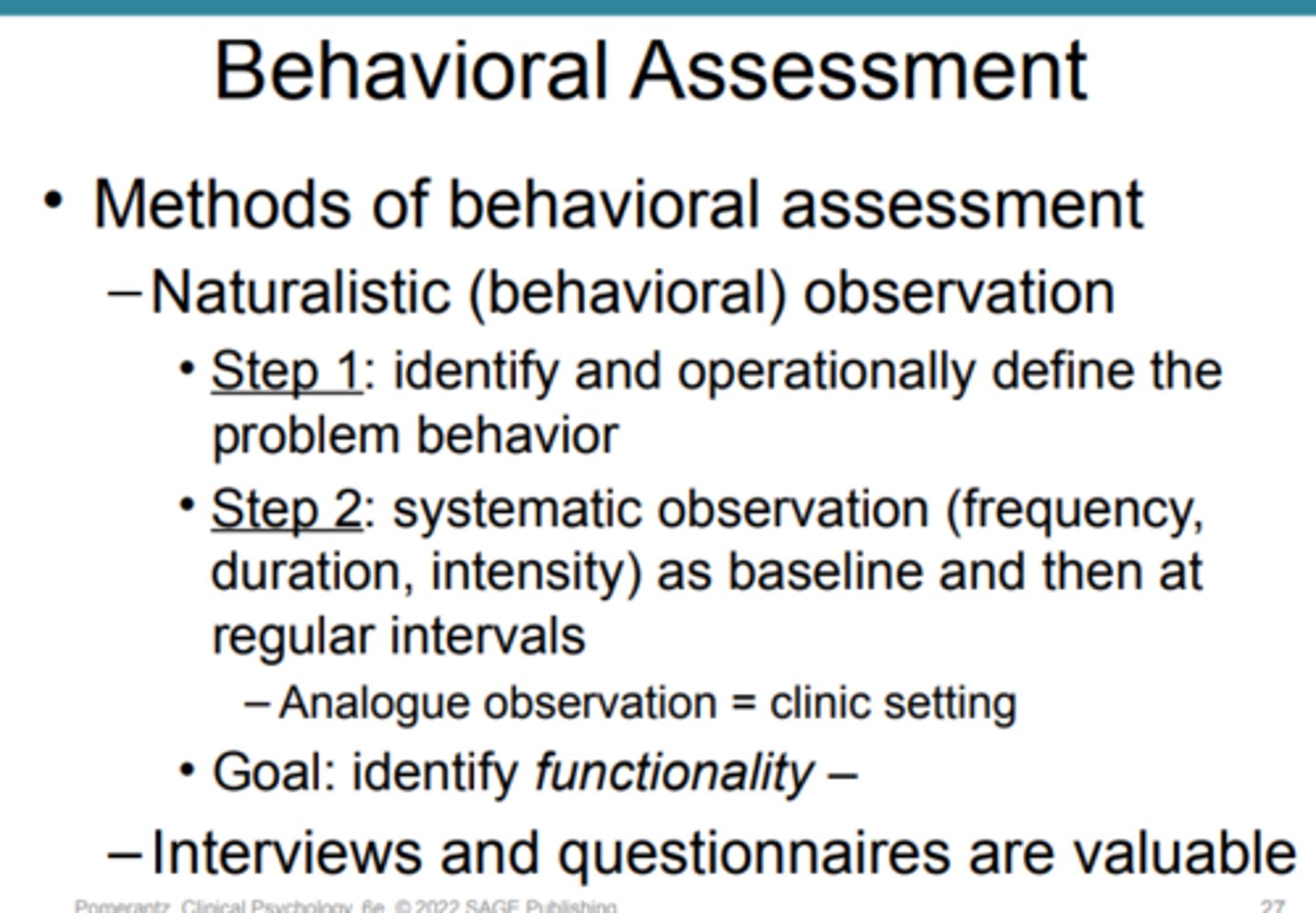Chapter 10: Personality Assessment and Behavioral Assessment
1/27
There's no tags or description
Looks like no tags are added yet.
Name | Mastery | Learn | Test | Matching | Spaced |
|---|
No study sessions yet.
28 Terms
Important Considerations for Personality Assessment:
Multimethod, Evidence-Based, and Culturally Competent
important considerations for personality assessment: multimethod assessment
evidence-based assessment
culturally competent assessment.
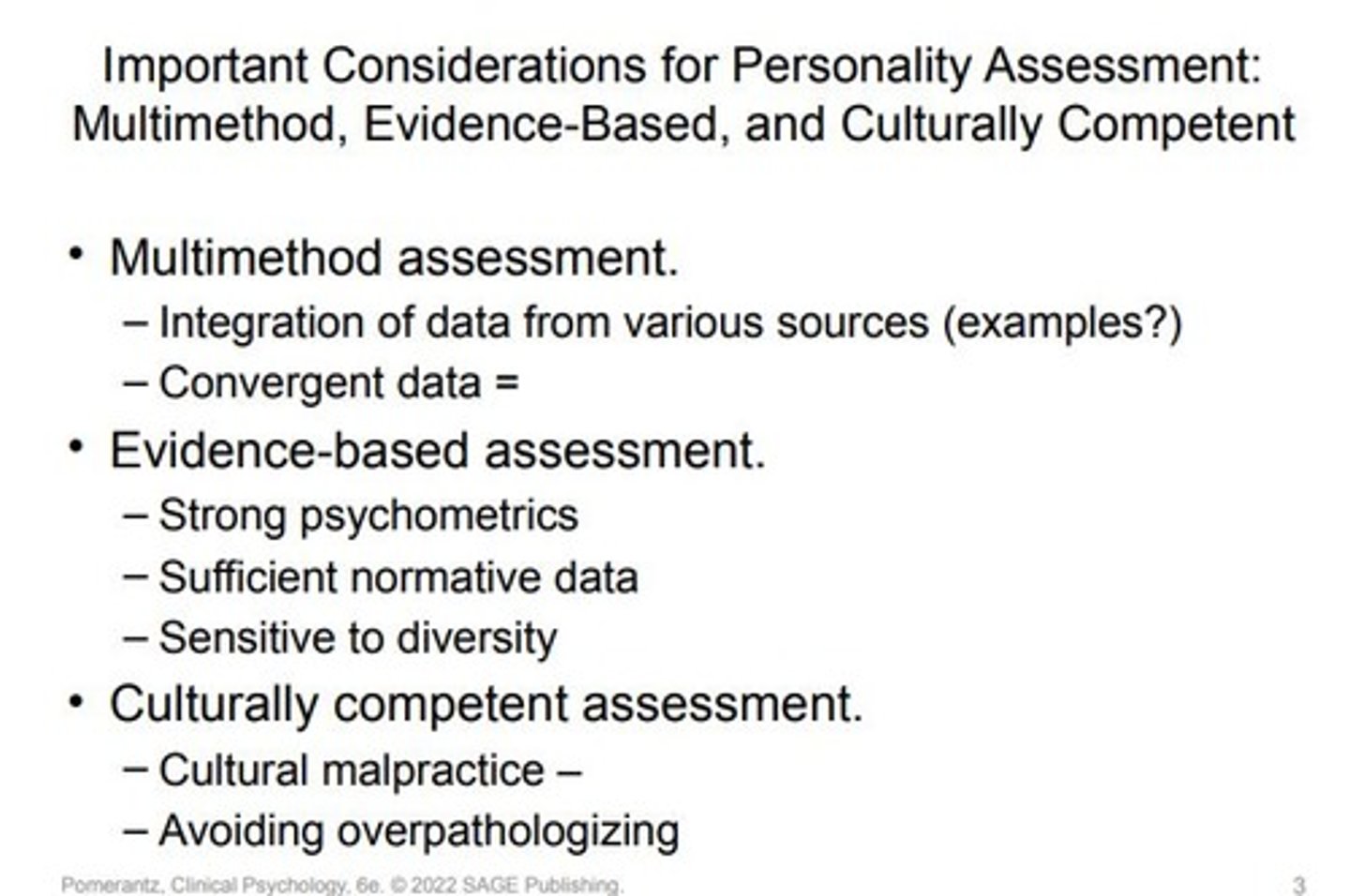
Multimethod Assessment
***An approach to assessment incorporating multiple methods, including tests of different types, interview data, observations, or other sources
Multimethod assessment in clinical psychology is vital because no single measure of personality or behavior is flawless. Just as one wouldn't rely solely on a first impression in a new relationship, a clinical psychologist shouldn't rely exclusively on a single test.
Viewing an individual's personality and behavior in various contexts, much like observing a partner in different situations, gives a comprehensive understanding.
Using diverse methods, such as tests, interviews, and observations, offers unique insights and ensures more accurate conclusions.
Evidence-Based Assessment
An approach to assessment emphasizing those methods that have strong psychometrics, clinical utility, and normative data and are sensitive to issues of diversity such as age, gender, race, and ethnicity
*** Reliability, validity, and clinical utility
Evidence-based assessment emphasizes tools with proven reliability and validity for specific clinical issues. Despite its growth in health care, there are challenges in defining "what works." Some caution against relying solely on manuals, emphasizing the importance of human interaction nuances. Clinical psychologists must balance empirical evidence with personal judgment and client needs.
Culturally Competent Assessment.
Cultural competence is crucial in personality assessment. Without it, psychologists risk "cultural malpractice" by misinterpreting culturally common behaviors as pathological. For instance, Dr. Platt wrongly diagnosed Duron, a Black client, with paranoia, neglecting Black cultural norms about mistrust when seeking services from White therapists. Bias can arise from the clinician, the test's language/structure, or the service delivery method. Psychologists must recognize and counteract these biases for culturally competent assessments
overpathologizing:
Viewing as psychopathological that which is culturally common or accepted
If a person receives a similar score on a personality assessment across the two time points, the assessment has a high ______.
quantitative assessment
a perfect correlation
validity
test-retest reliability
test-retest reliability
Multiple methods for assessing personality are used because
psychologists do not have time to use interview techniques exclusively
all personality measures have limitations
personality is the most complex variable psychologists study
clients may lie about their true personalities
all personality measures have limitations
Choosing the proper assessment for clients means integrating "what works" with what is available.
T/F
False
Targeting clients and keeping their interests in mind is a critical facet of choosing the proper assessment
Objective Personality Tests vs Performance based tests
Objective personality tests:
-Feature clear test items.
-Have limited response options.
-Are objectively scored.
-Mostly in the form of questionnaires with true/false or multiple-choice responses.
Performance-based tests (also known as projective tests):
-Use ambiguous stimuli.
-Offer an open-ended response range.
-Assume clients reveal their personalities by interpreting vaguely defined objects or situations.
Types of objective personality tests
Name all 5
-Minnesota Multiphasic Personality Inventory (MMPI)
-Personality Assessment Inventory (PAI)
-Millon Clinical Multiaxial Inventory-IV
-NEO Personality Inventory-3 (2005)
-Beck Depression Inventory-II (+Other Symptom-Specific Objective Tests)

Minnesota Multiphasic Personality Inventory (MMPI)
The Minnesota Multiphasic Personality Inventory (MMPI) is a widely-used and reputable objective personality test. It consists of hundreds of true/false self-descriptive sentences, covering various behaviors, feelings, and attitudes. Clients mark each statement based on its relevance to them.
The MMPI is globally recognized and available in numerous languages.
***The most recent version of the MMPI is the MMPI-3, released in 2020.
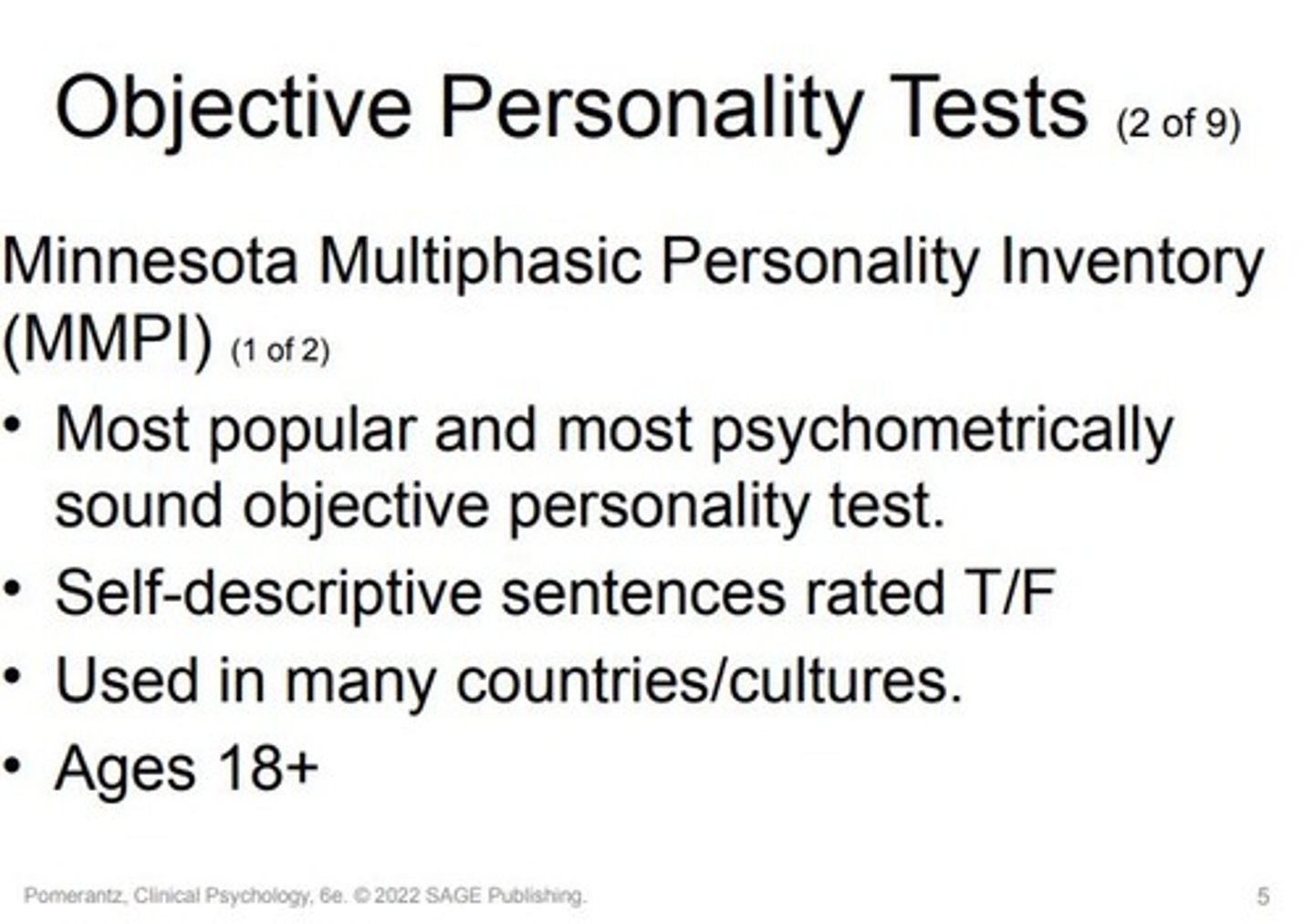
Development of the Original MMPI
The Minnesota Multiphasic Personality Inventory (MMPI) was first published in 1943, designed by Starke Hathaway and J.C. McKinley.
They sought an empirical method to gauge psychopathology, unlike existing questionnaires. They utilized "empirical criterion keying" for test construction. This means they tested items on distinct groups (e.g., people diagnosed with specific mental disorders) and retained items only if they differentiated between these groups in practice, not just in theory.
Of over 1,000 initial items, 550 made the cut, forming 10 clinical scales related to different psychopathologies.
the MMPI prioritized empirical data over intuition or theory in item selection, much like how Amazon suggests products based on buying patterns, not perceived item similarities.

Measuring Test-Taking Attitudes: The MMPI Validity Scales
The MMPI includes validity scales to assess clients' test-taking attitudes and detect dishonest or indifferent responses. Hathaway and McKinley designed these scales to identify when clients exaggerate symptoms ("fake bad"), downplay them ("faking good"), or answer randomly. The main validity scales are L (Lying, "faking good"), K (Defensiveness, "faking good"), and F (Infrequency, "faking bad"). For instance, if Tammy's MMPI results suggest severe psychopathology but the validity scales show she exaggerated her symptoms (potentially malingering), the psychologist might deem her results as questionable or interpret them with caution.
Personality Assessment Inventory (PAI)
-Contains 344 items.
-Suitable for ages 18-89.
-Adolescent version (PAI-A) for ages 12 and up.
-Requires a fourth-grade reading level.
-Four response options per item: totally false, slightly true, mainly true, and very true.
-Has validity scales similar to MMPI to determine the test-taking approach.
-Features 11 clinical scales:
Some align with MMPI scales.
Others specific to diagnoses like:
Borderline Features
Antisocial Features
Anxiety-Related Disorders
Alcohol Problems
Drug Problems
Direct correspondence to certain DSM disorders is a noted strength
.
Developed by Leslie Morey in 1991.
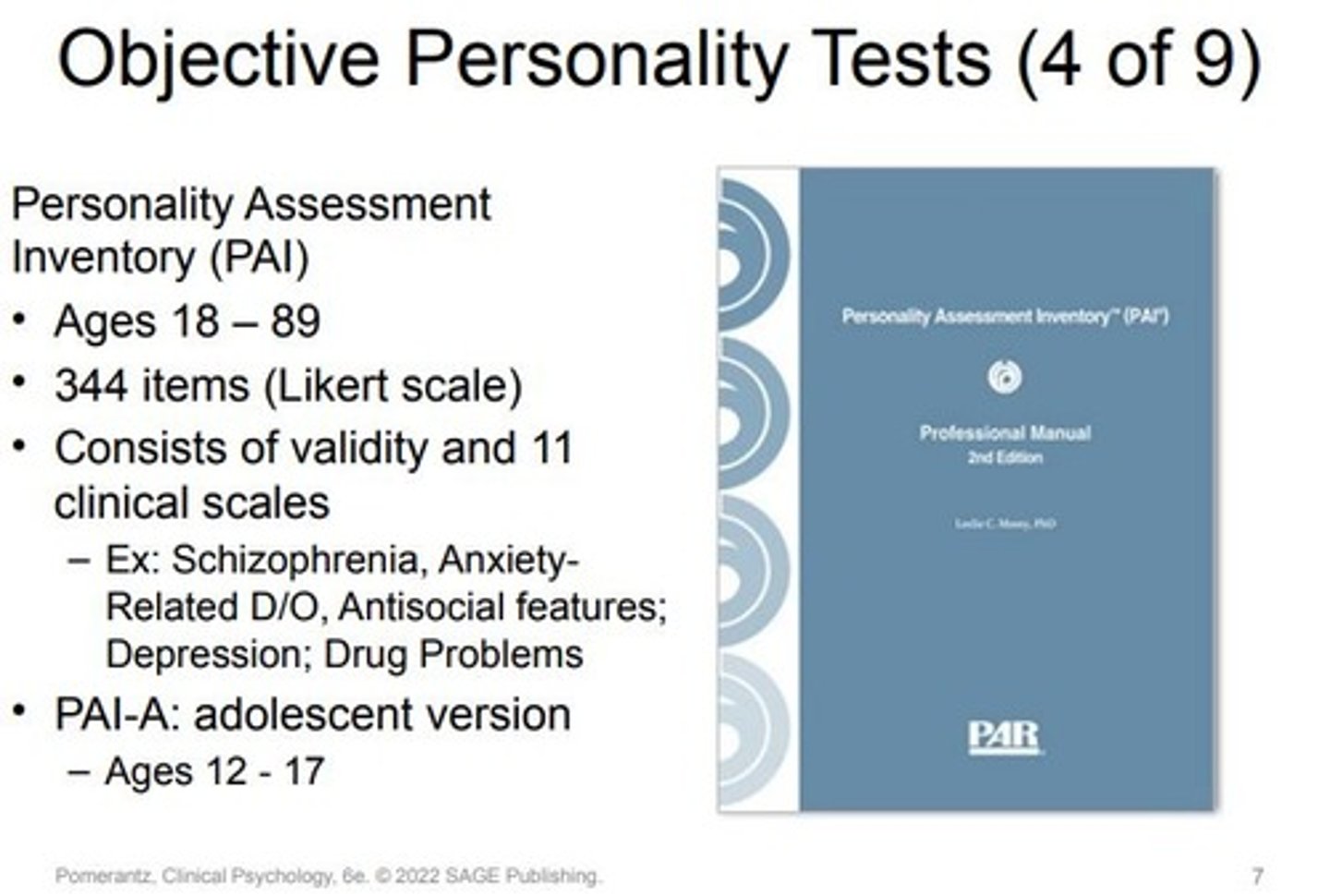
Millon Clinical Multiaxial Inventory-IV
The current version of a comprehensive objective personality test that emphasizes personality disorders
-Comprehensive personality test similar to MMPI and PAI.
-Emphasizes personality disorders.
-Includes scales for major clinical syndromes (e.g., depression, anxiety).
-Features scales for all 10 current DSM personality disorders (e.g., antisocial, narcissistic).
-Offers scales for additional personality pathologies not in DSM (e.g., self-defeating, turbulent personality).
-Created for adults. Separate versions for adolescents, children, and medical contexts.
-Originally developed by Theodore Millon in 1977; MCMI-IV version was published in 2015.
Consists of 195 true/false items.
Incorporates “modifier indices” akin to MMPI’s validity scales.
Adolescent version: Millon Adolescent Clinical Inventory (MACI) has 160 items for ages 13–19
.
Strong reliability and validity data; ideal for assessing personality disorders
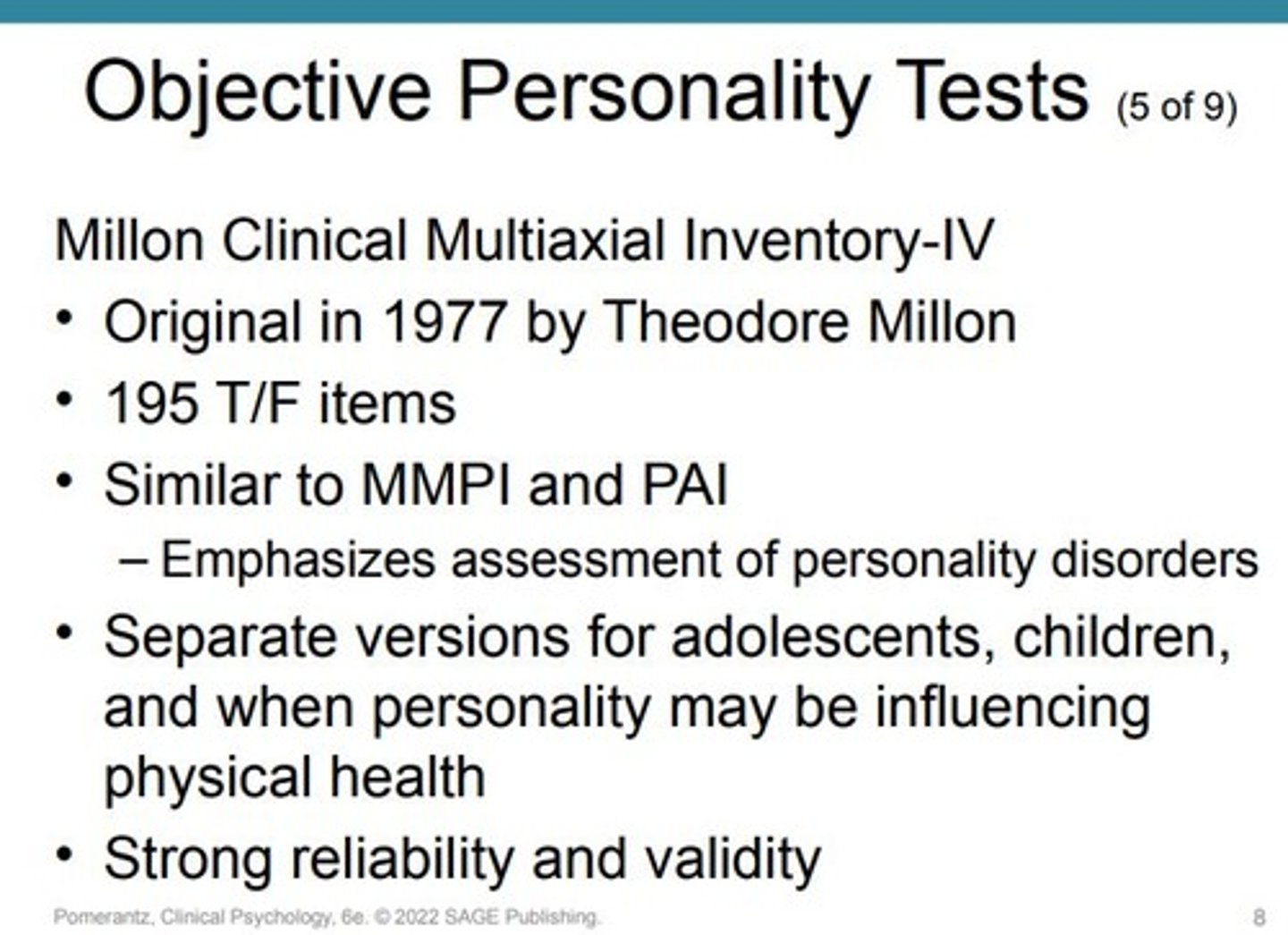
NEO Personality Inventory-3 (2005)
Purpose: Measures common, nondisordered personality characteristics, differentiating from MMPI, MCMI, and PAI.
Authors: Paul Costa and Robert McCrae.
Foundation: Five-factor model of personality or "Big Five".
Main Traits Measured:
Neuroticism
Extraversion
Openness
Agreeableness
Conscientiousness
Sub-traits: 30 “facet” scores (six facets for each of the five main traits).
Format:240-item self-report questionnaire. Items have multiple-choice responses ("strongly agree" to "strongly disagree").
Versions:Original: 1985Revised: NEO-PI-R in 1992NEO-PI-3: 2005Short form: NEO Five-Factor Inventory (NEO-FFI) with 60 items.
Purpose of NEO-PI-3 revision: Improved readability and comprehension of 37 items.
Criticisms: Lack of validity scales.Vulnerability to "faking" or inattention.Limited clinical utility in terms of diagnosis.
Benefits: Some disorders, especially personality ones, show strong correlations with NEO-PI-3 scores, enhancing its clinical relevance.
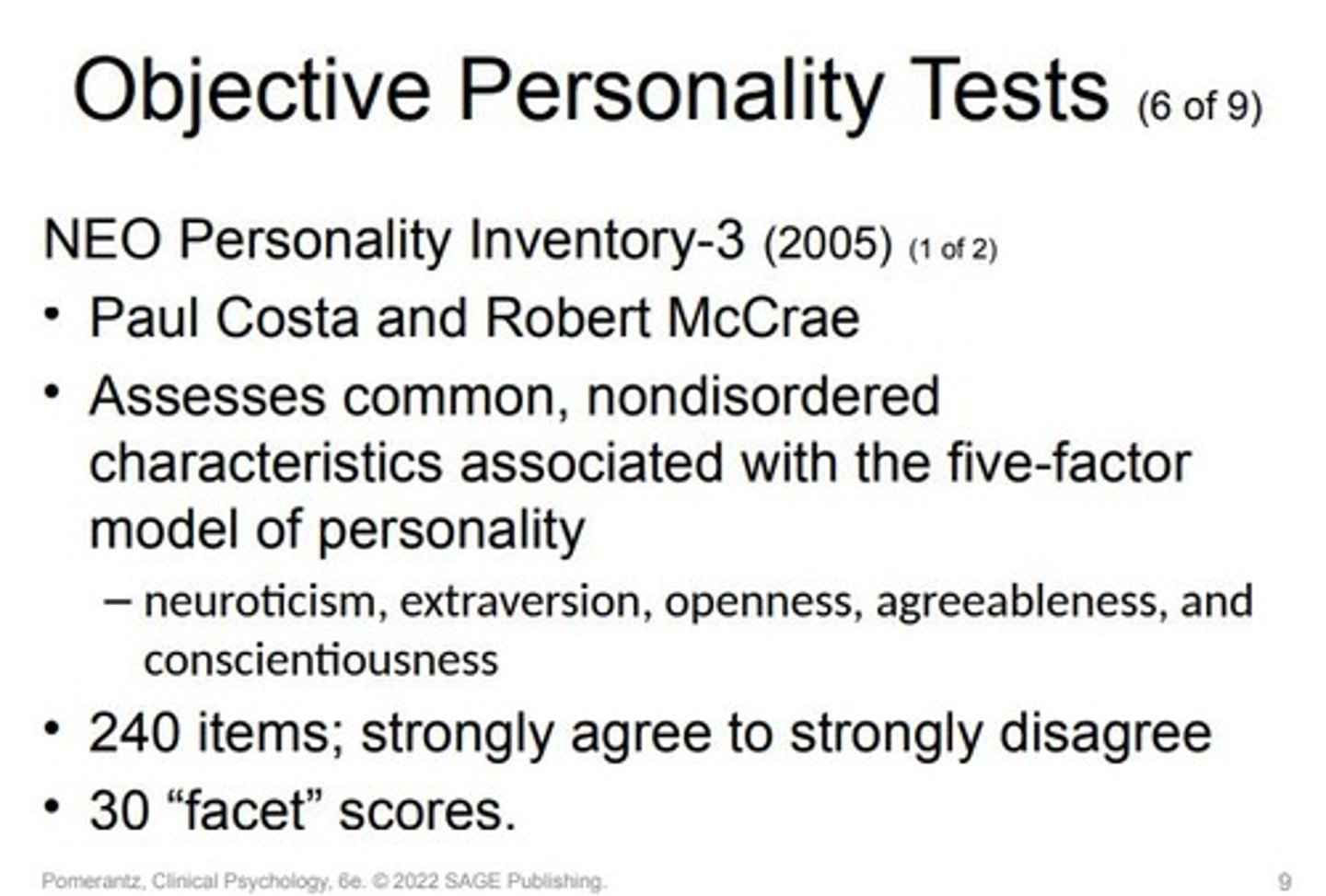
NEO Personality Inventory-3 (2005)

Beck Depression Inventory-II and Other Symptom-Specific Objective Tests
Purpose: Targeted objective measures that focus on specific symptoms or characteristics instead of providing a broad overview of personality.
Examples: BDI-II, Beck Hopelessness Scale, Beck Anxiety Scale.
BDI-II Details:Format: Self-report, pencil-and-paper test.
Population: Adults and adolescents.
Author: Aaron Beck. ***(father of developing CBT)
Original Version: 1960s.
Current Revision: 1996.
Test Length: 21 items, 5-10 minutes to complete.
Focus: Assesses depressive symptoms over the past 2 weeks.
Scoring: Items related to depressive symptoms ranked in order of increasing severity. Scores sum to reflect overall level of depression.
Example Item: Statements about thinking of dying, scored from 0 to 3 points.
Limitations: No validity scales and limited scope.
Strengths: Established reliability and validity.
Increasing Trend:Using ambulatory assessment to gather real-time data on symptoms.Devices used: smartphones, Fitbits, Apple Watches, etc.Applications: Monitoring sleep patterns, movement patterns, daily self-report surveys on symptoms.Advantages and Challenges: Ethical and practical issues but offers notable benefits for real-time data collection.
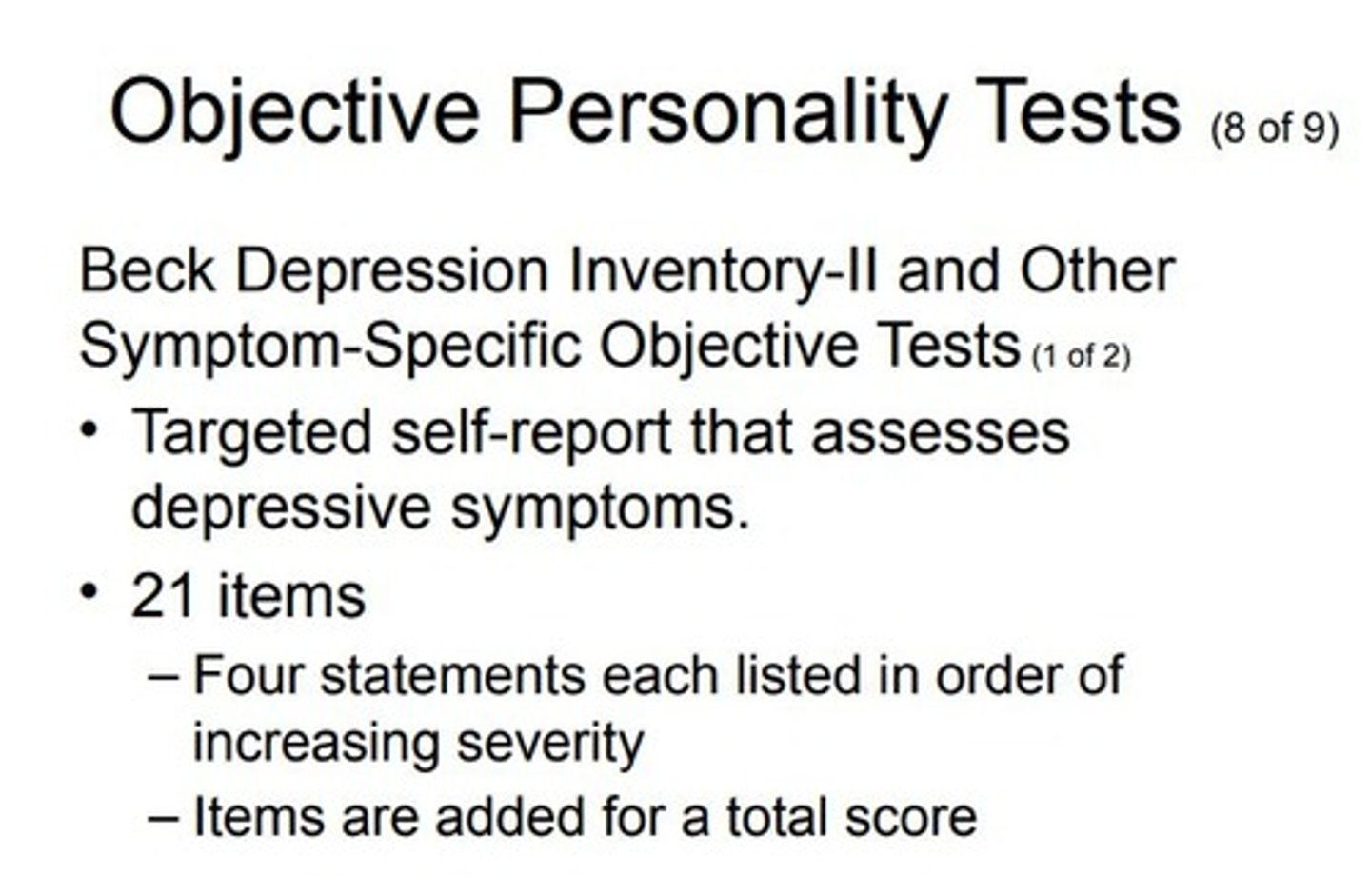
Beck Depression Inventory-II - sample
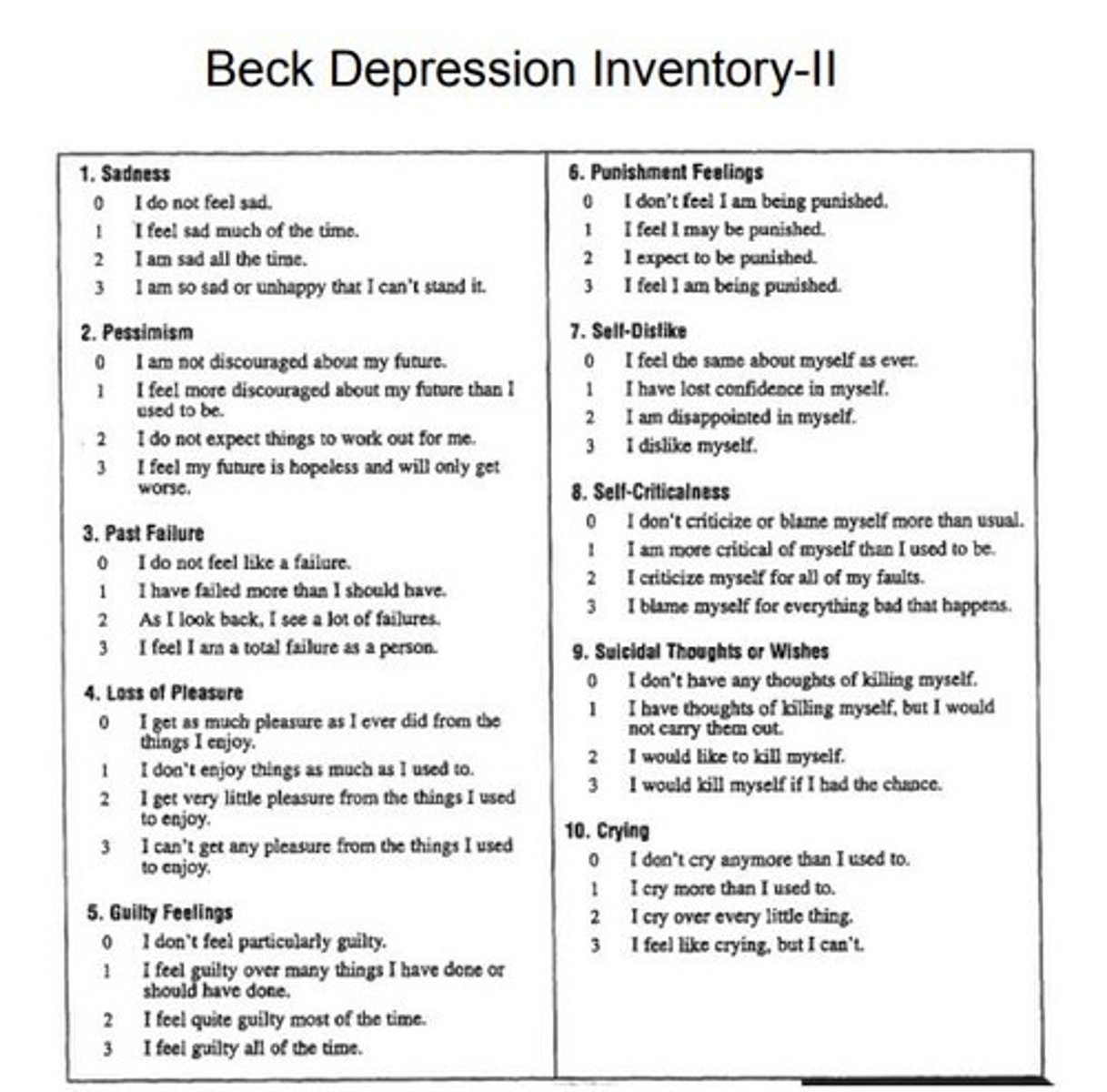
Beck Depression Inventory - limitations
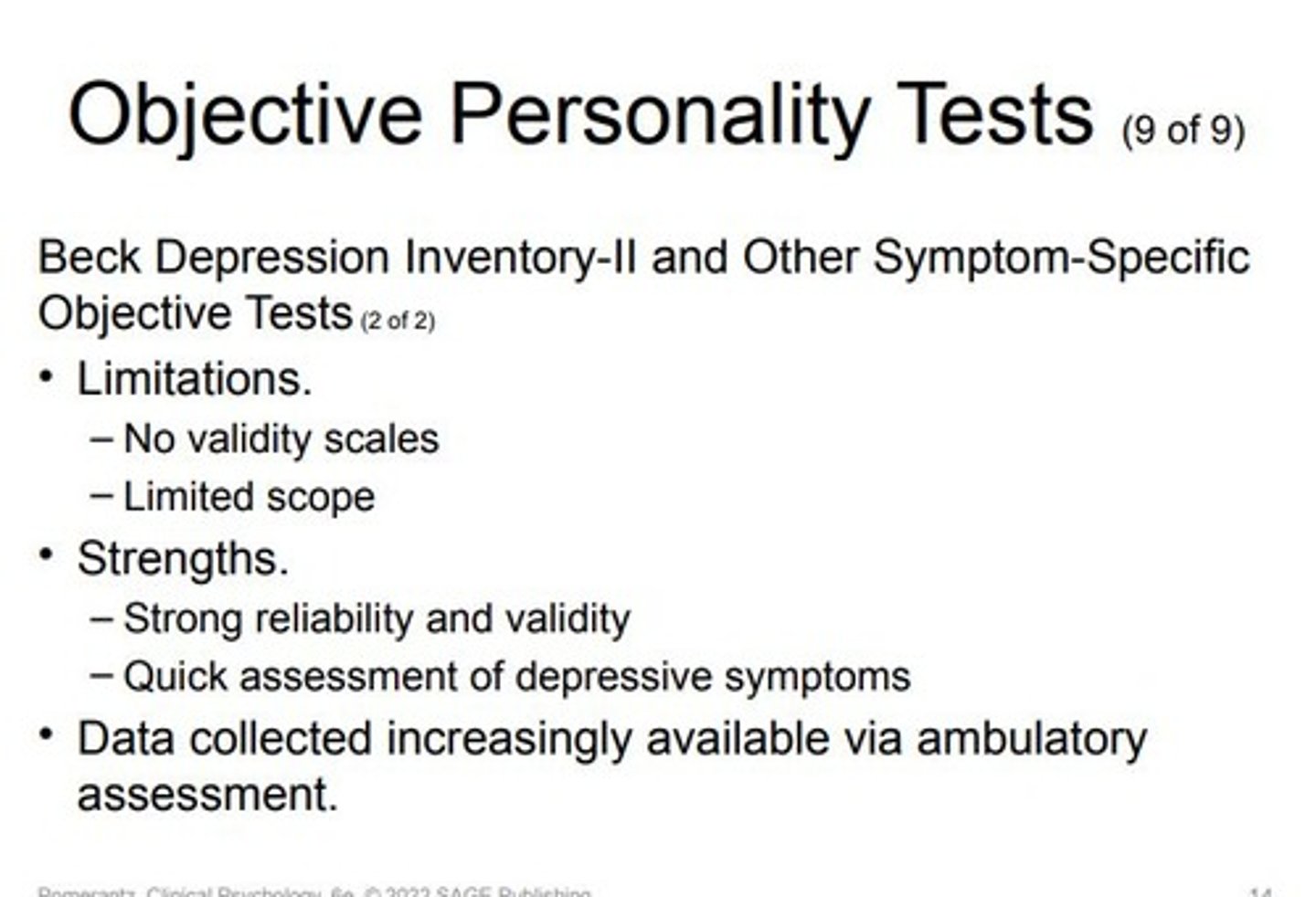
Performance-Based Personality Tests
A personality test in which individuals are assumed to project their personality characteristics via responses to ambiguous or vague stimuli
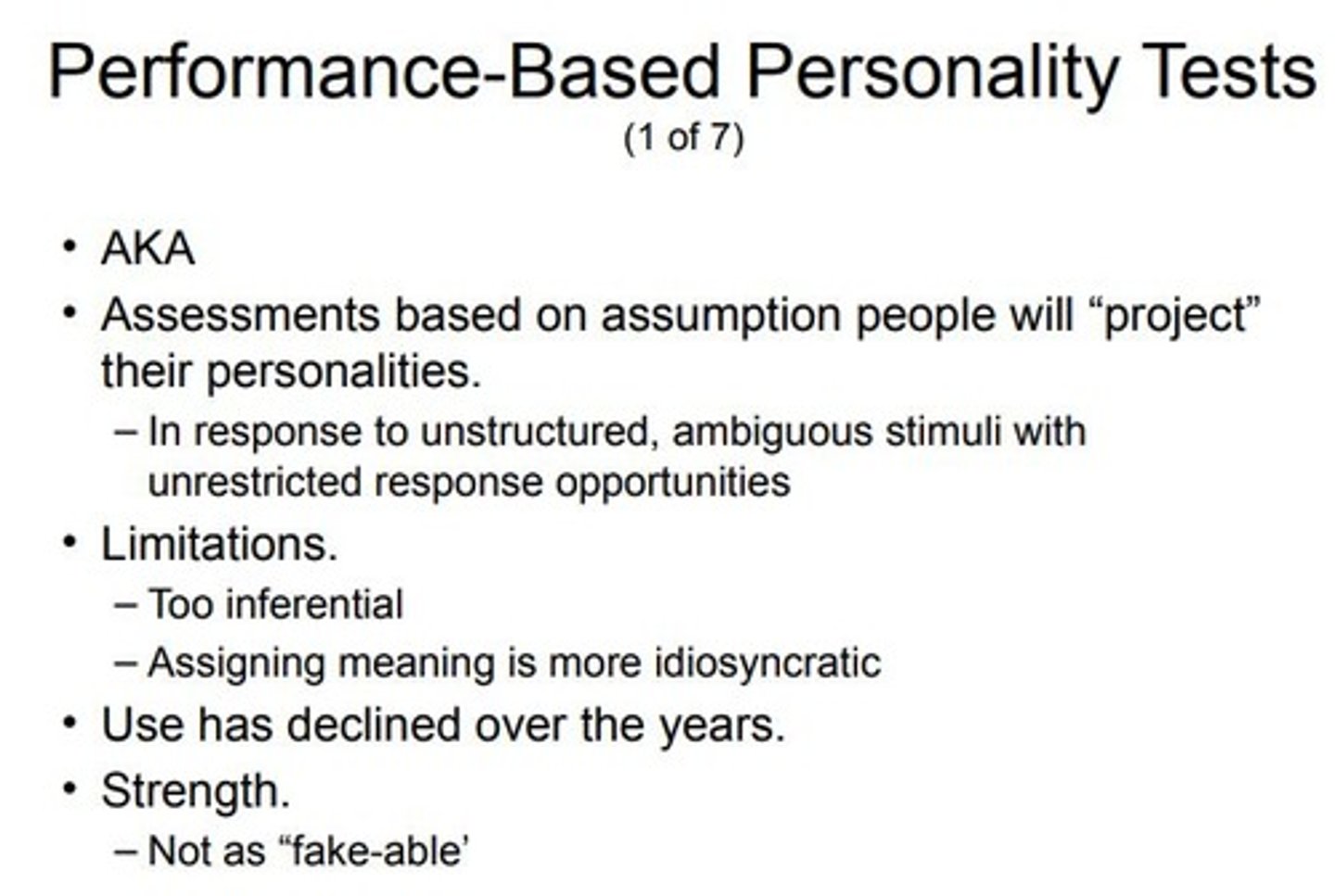
Types of Performance-Based Personality Tests
-Rorschach Inkblot Method
-Thematic Apperception Test (TAT):
Children’s Apperception Test (CAT).
Senior Apperception Test (SAT).
The Tell-Me-a-Story (TEMAS)
Sentence Completion Tests
Rorschach Inkblot Method
Origin:
Developed by Hermann Rorschach in 1921.
Inspired by a childhood game where participants interpret inkblots.
Original intention: reveal personality characteristics.
Test Features:
Consists of 10 inkblots: 5 in black ink, 5 in multiple colors.
Two-phase administration:"Response" phase: presentation and free association."Inquiry" phase: clarification of responses.
Scoring Systems:
Original publication didn't have a scoring method.
After Rorschach's death, many scoring systems were developed.
Exner’s Comprehensive System (1986):Unified various scoring methods.Includes normative data from thousands.
Rorschach Performance Assessment System (R-PAS, 2011): Aimed at a stronger empirical basis and diversified norms.
Internet-based scoring and other refinements.Attracted significant use and demonstrated strong psychometric qualities.
Scoring Criteria:
Focuses on the process of interpretation more than content.
Variables assessed include:Location within the card.Determinants (shape, color, shading).Distortion level.Response popularity.Perceived movement within the inkblot.Content and themes.
Interpretation:
The way clients interpret inkblots parallels how they interpret the world.
For example, distortion in inkblots may relate to distorted judgments in life.
Debate and Criticism:
Supporters emphasize strong reliability and validity data, especially with the rise of R-PAS.
Critics highlight concerns over reliability, validity, and complex scoring.
Some norms may be inadequate for certain populations.
Meta-analyses show that some variables, especially those measuring psychoticism and cognitive complexity, are valid.
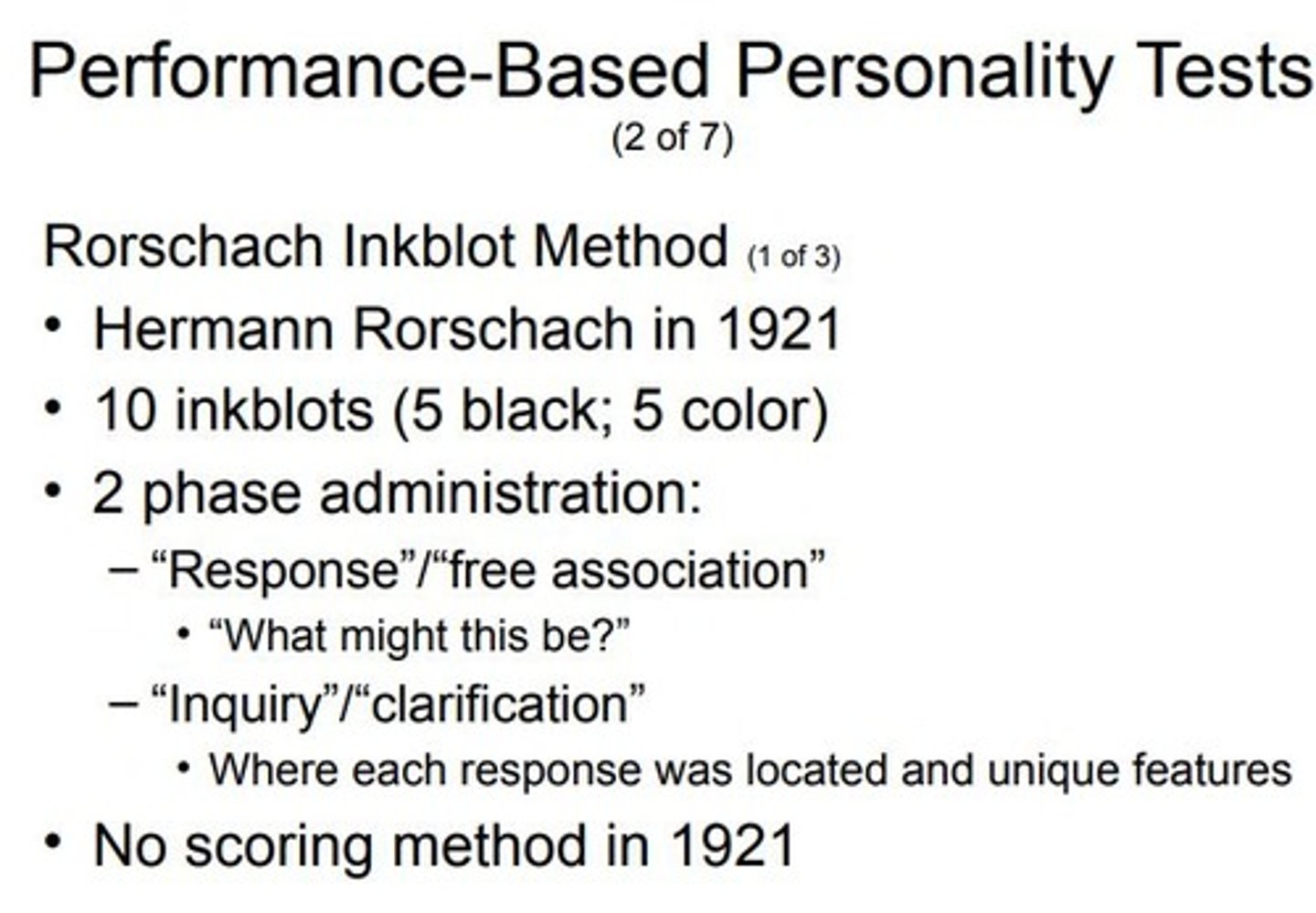
Rorschach Inkblot Method
Comprehensive System and R-PAS
Rorschach Inkblot Method
• John Exner. – Comprehensive System
• Used across lifespan •
Rorschach Performance Assessment System (R-PAS; 2011). – Incorporates variables with more definitive empirical evidence
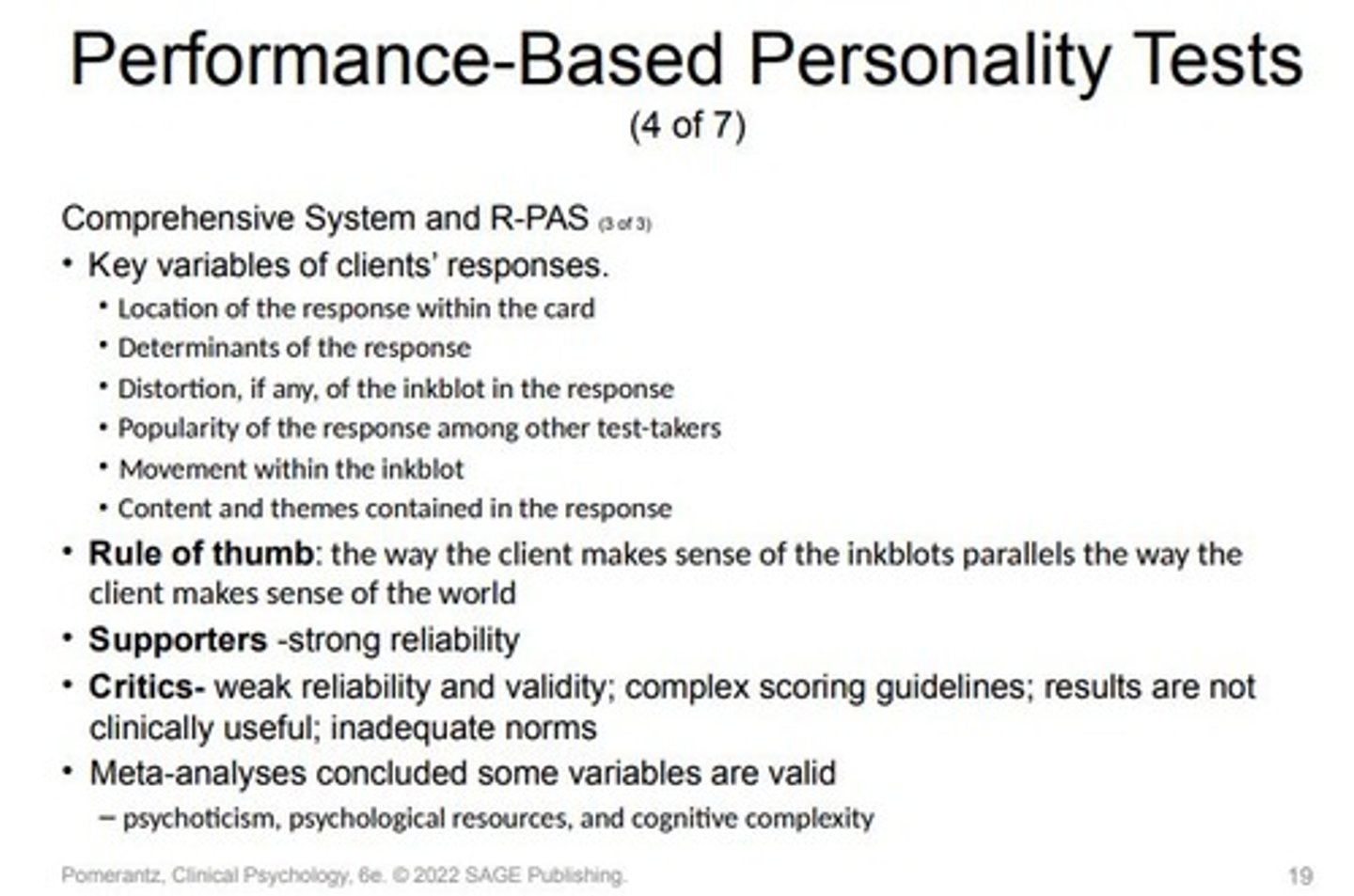
Thematic Apperception Test
Origin: Developed by Henry Murray and Christiana Morgan in the 1930s.
Stimulus:
Features interpersonal scenes on cards.
Unlike the Rorschach’s inkblots.
Task for Clients:
Create a narrative for each scene.
Discuss the past, present, and potential future of the scene.
Describe the characters’ thoughts and feelings.
Strength: Measures interpersonal relationship tendencies.
Administration:
Contains 31 cards, but typically 10 are selected for a session.
Stories are told aloud and recorded by the psychologist.
Some scoring systems exist, but formal scoring is often neglected.
Interpretation:
Largely impressionistic; varies from one psychologist to another.
More of an art than a scientific process.
Criticisms:
Lack of empirical support and uniformity.
Henry Murray emphasized its hypotheses nature.
Related Tests:
Children’s Apperception Test (CAT).
Senior Apperception Test (SAT).
Tell-Me-a-Story (TEMAS) Test:
TAT-style test for children and adolescents.
Emphasizes empirical scoring and cultural sensitivity.
Initially for Hispanic youth, expanded to Black and White youth.
– Greater emphasis on empirical scoring via normative data and cultural sensitivity
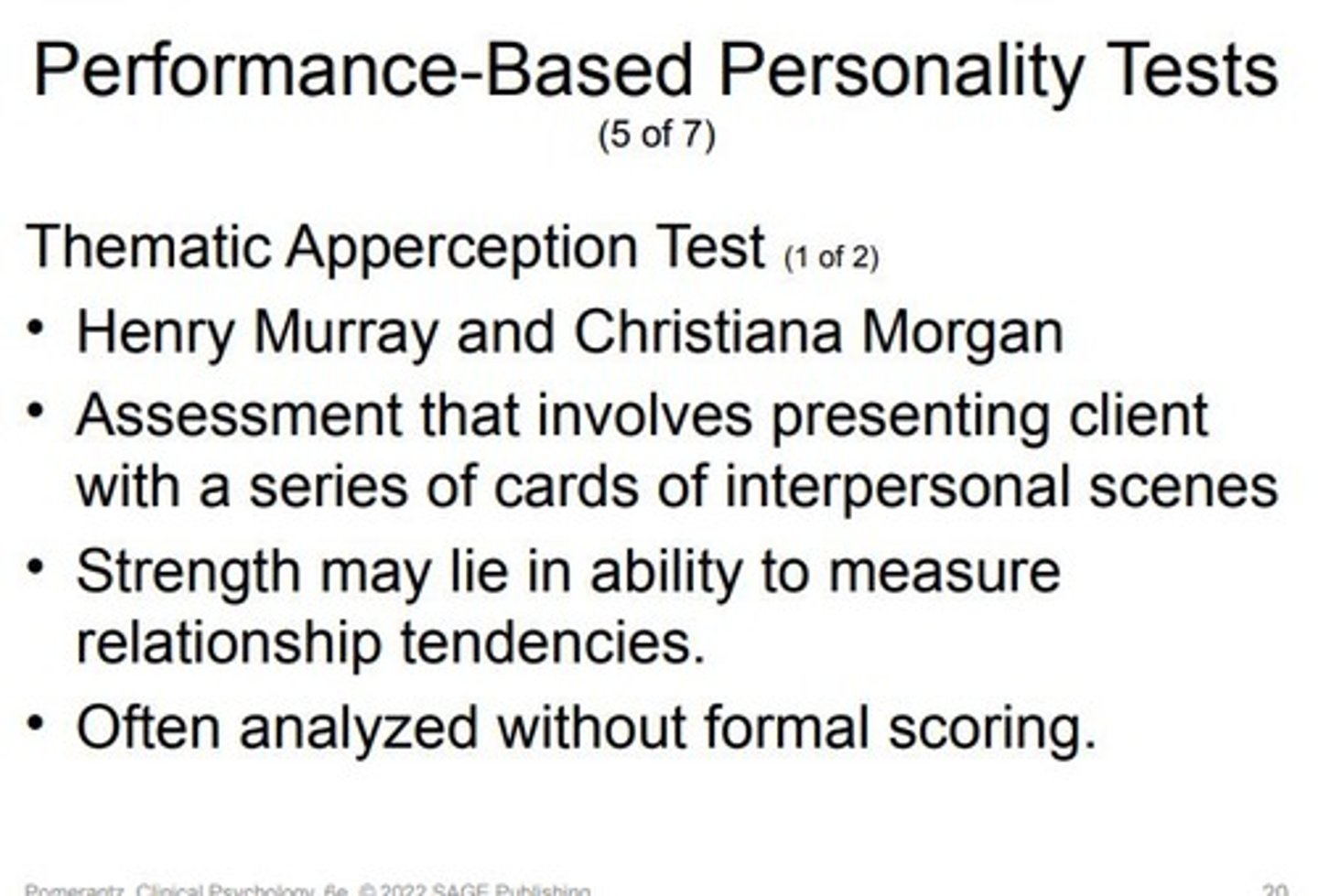
Sentence Completion Tests
Type of Stimuli: Beginnings of sentences.
Assumption: Personalities revealed through sentence endings.
Notable Test: Rotter Incomplete Sentences Blank (RISB).Most recent edition: 1992.Includes 40 sentence "stems."
Scoring: Has a formal system. Often unused or dependent on clinician judgment. Scientific validity is debated.
Utility:
Complements information from other tests.
Offers qualitative insights into conditions like depression.
The summary captures the essence of sentence completion tests and their utility in psychological assessment.
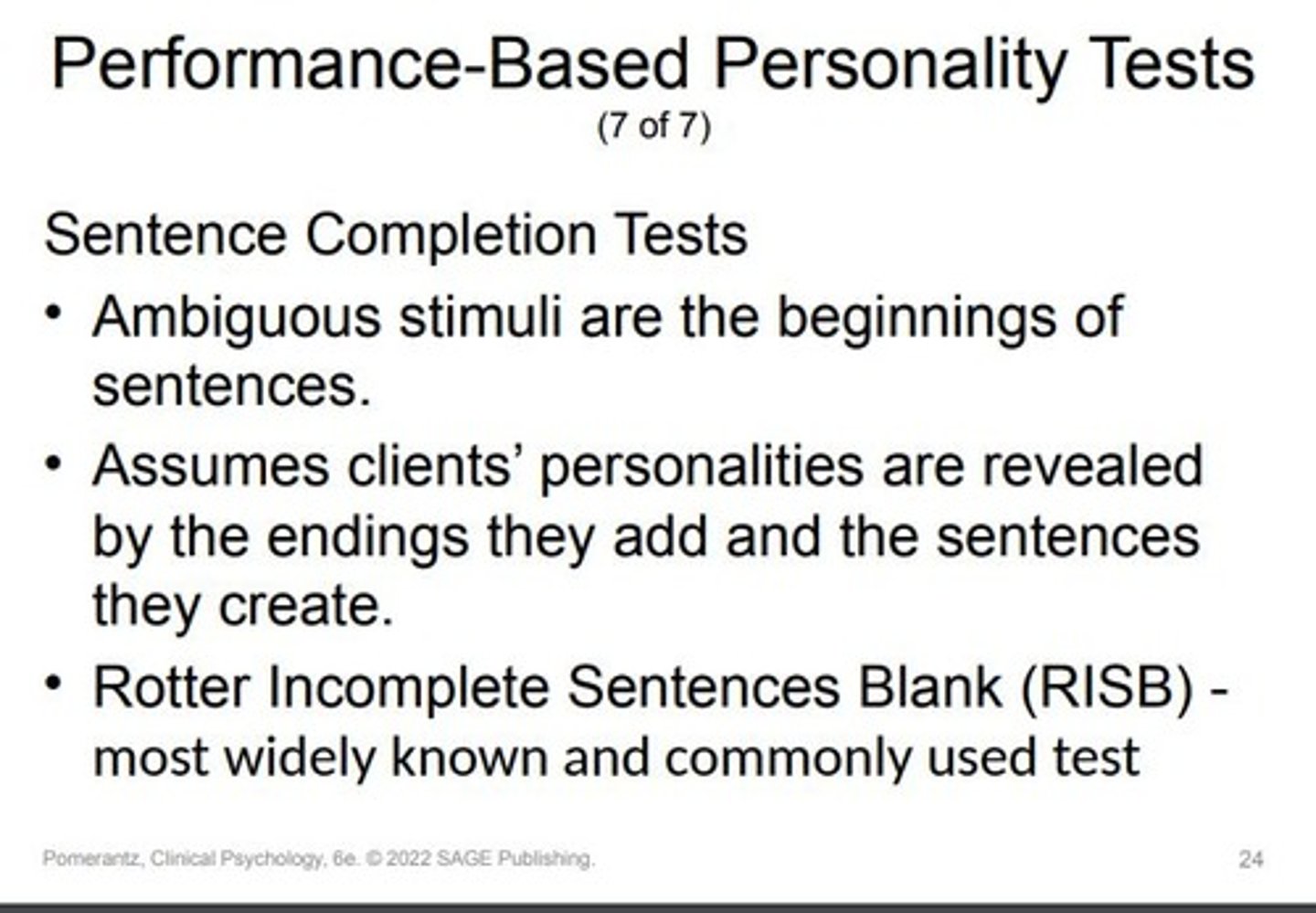
Behavioral Assessment
Traditional Assumptions:
Personality is a stable, internal construct.
Assessment requires inference.
Behaviors are signs of deeper issues or DSM diagnoses.
Behavioral Assessment Perspective:
Client behaviors are the problems, not signs of underlying issues.
Focus on direct measurement, e.g., observing behavior in context.
Rejects notion of internal disorders causing behaviors.
Argues external, situational factors shape behavior.
Features:
Empirical approach.
Emphasizes behavior-environment interactions.
Diagnoses behavior problems, not clients.
Behavioral assessment offers a contrasting perspective to traditional assessment methods by focusing directly on the problematic behaviors and their situational causes.
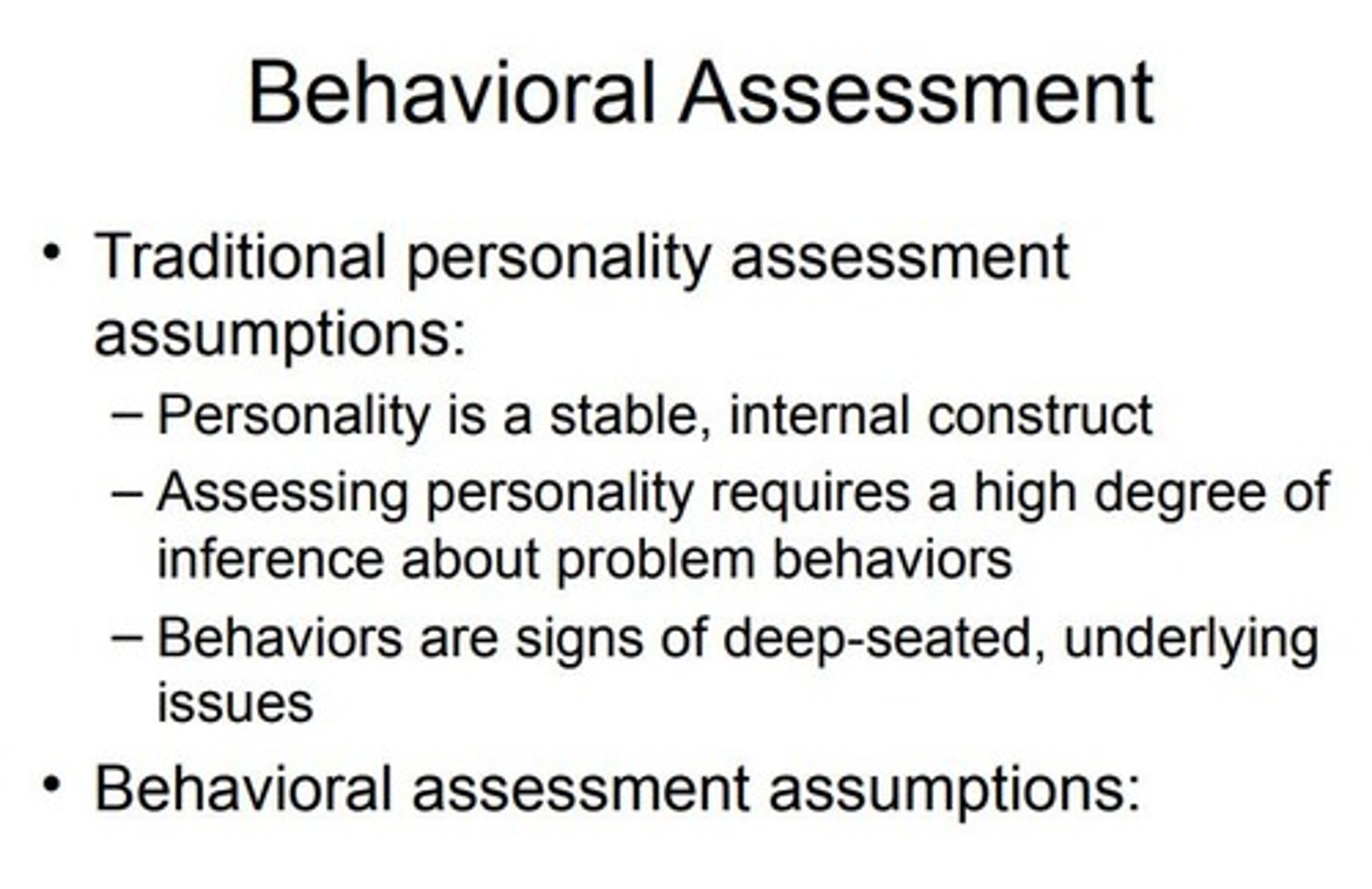
Methods of Behavioral Assessment
Behavioral Observation:
Direct, systematic observation in natural environments.
Involves identifying and defining the problem behavior through various means.
Systematically tracks frequency, duration, or intensity of the behavior.
Analogue observation can replicate real-world settings in a clinic.
Recording Context:
Records events before (antecedents) and after (consequences) the behavior.
Helps understand behavior's functionality and relation to its environment.
Example with Thiago:
Observing classroom behavior and noting antecedents and consequences.
Analyzes stimuli or events triggering arguments and their outcomes.
Functional Techniques:
Use of functional interviews and functional questionnaires.
Focus on identifying the function of the problem behavior.
Can guide and complement behavioral observation.
Behavioral assessment emphasizes direct observation and understanding of the functional relationships between behaviors and their surrounding context, offering a unique perspective on problem behaviors.
